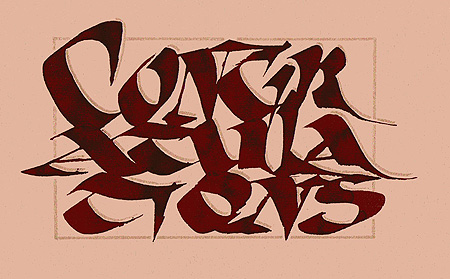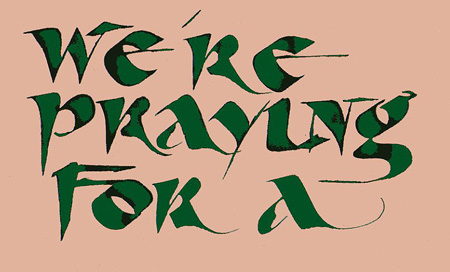
In the same box with the concrete poems or typewriter art of the previous post were some scraps from a project I did for a local church. I submitted sample pages in different styles, intending to do the project in the style they chose. These were among the styles they rejected. Maybe there were two projects, I can't remember. But, I do remember it ended up being several pages, stitched with card stock and then wrapped in handmade paper. Unfortunately, I also remember they wanted something more like block letters so they could read it. There's a reason television requires no insight and no training to watch. It looked like a Parents Day gift from the elementary school when it was done, except the paper was more expensive, and the letters better spaced. They weren't sure about the paper either. One of them asked, "How come it's not white?" In general, doing business with churches is not the best idea. The stupidest person of the bunch is usually its leader, and if not the leader, then the head of whatever committee happens to be in charge. "This Christmas we're going to decorate the church in red and yellow, because I decorated my house in red and yellow, and I really like it. It's stylish." And she donated how much last year?

If I were doing this again, I'd do it differently. I'd probably use a computer, since handmade things look woefully inaccurate today. Most things are like that. The letters were made with a witches' pen, sometimes called a poster pen, though there are numerous kinds of those — a piece of metal folded over with tiny holes along the bend. It has nothing sharp to catch the paper, like a pointy nib, so it can be pushed in any direction, even tilted and twisted, as the stroke is made. The ragged edges result from one side or the other of the nib losing contact with the paper. The ink tries to decide which way to go, toward the paper or back to the pen. I learned this technique studying the alphabets and writing samples of Arthur Baker that were published in the seventies and early eighties. His fonts, which are mostly pen based, are available at MyFonts.
I'm not sure what congratulations were in order, or what they were praying for, but it reminds me of a Sunday school story about a church missionary. I'll call him Dr. Johnson. The Sunday school teacher asked her class to write letters to their missionary overseas. But, she explained, Dr. Johnson has a great deal to do, so the letters should be short and not filled with questions, because if Dr. Johnson has to read and then answer all the letters, he won't have time to do his missionary work. A girl in the class wrote, "Dear Dr. Johnson, We are praying for your mission, but we are not expecting an answer."

